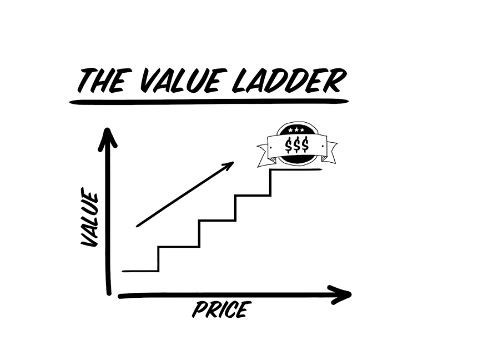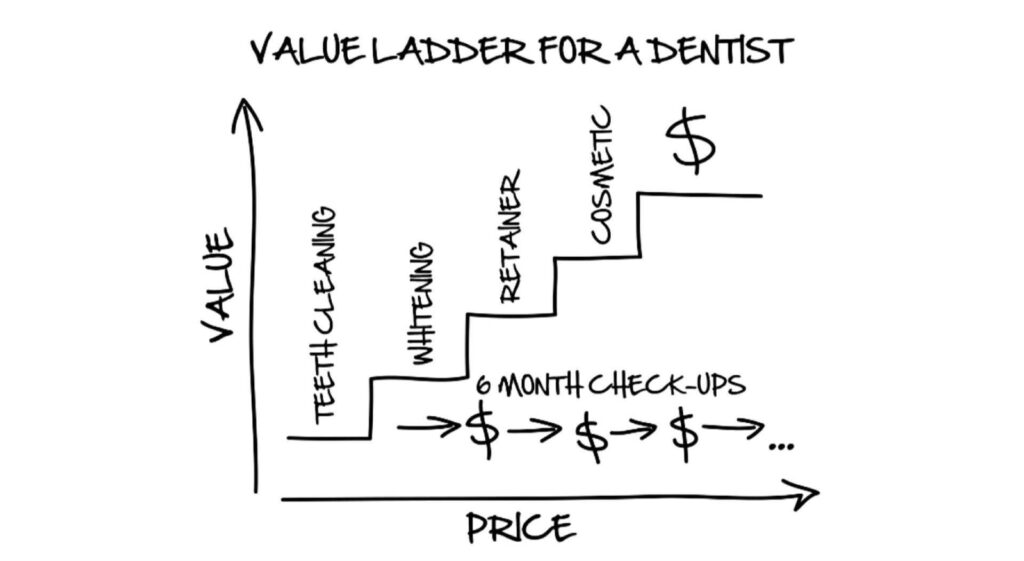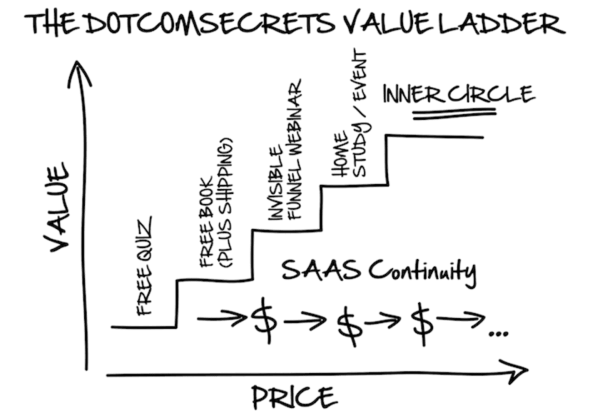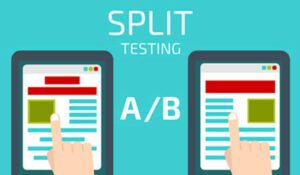If you’ve heard about the concept of a value ladder and have no idea of what it is then read on.
I first learnt this concept from Russell Brunson, which he outlines it in his book DotCom Secrets.
In this post I’ll break down what a value ladder is, why your business needs one, and how to create one.
What is a value ladder?
 A value ladder is a series of products or services you introduce to your customers as your relationship with them develops. Each subsequent product or service increases in the value it delivers to your customers and the price they pay for it.
A value ladder is a series of products or services you introduce to your customers as your relationship with them develops. Each subsequent product or service increases in the value it delivers to your customers and the price they pay for it.
Your customer starts at the bottom of your value ladder and ascends to the top as they purchase more products and services from you, each being more expensive and offering more value than the one before it.
A value ladder is similar to a sales funnel, with the stages of your funnel being the same as your value ladder. The fundamental difference is a sales funnel is the online steps you take someone through so they can ascend through the different levels of your value ladder.
Why does your business need a value ladder?
If you run any sort of business, having a value ladder in place is essential as it clarifies exactly where you are taking each customer you acquire.
To acquire a customer takes time and money, and once you have acquired a customer you don’t want to sell to them only once – you want to sell to them as many times as possible. Businesses spend a fortune to acquire new customers, and once they have them they want to retain them as customers for the purpose of selling them more products and services and increasing their customer lifetime value.
The most successful businesses don’t just offer one product or service; they have a multitude of products and services they can offer their customers. Your value ladder is the sequence of products or services you will offer your customers, starting from your entry-level products to your higher-end products or services.
Let’s use some examples to make this more clear:
Value ladder for an offline business
Let’s say you run a dental practice, your value ladder may look like this:

The bottom end of the value ladder is a free teeth cleaning service, and at the top end are more expensive cosmetic procedures. The first product or offer (free teeth cleaning) is used to get people through the door, and once they are in they can be offered subsequent services like whitening, retainers, or cosmetic procedures like crowns etc.
You can also see the dentist has a continuity service of check-ups every 6 months. You get them through the door with a free offer and then you keep them as a customer by offering regular check-ups and more expensive treatments.
Value ladder for an online business
This value ladder concept works in exactly the same way online as it does offline.
In the online world, the first product can be a free product or lead magnet such as a free guide, report, checklist, or cheat sheet etc.
Click here to learn about the best types of lead magnets
In order to get your lead magnet someone has to opt-in to your email list, and once they are on your list you can develop your relationship with them and introduce them to the other products in your value ladder in ascending order.
Here is an example of Russell Brunson’s value ladder which he uses to promote his Dot Com Secrets book.

As you can see he gets them onto his value ladder with a free quiz, and eventually ascends them up the ladder until they become members of his inner circle, whilst paying for his ClickFunnels software on a continuity basis.
Benefits Of Having A Value Ladder
There are several benefits and reasons why your business needs a value ladder:
Sell more products to existing customers
Having your value ladder enables you to offer more value, products, and services to customers once they have joined your list or made an initial purchase.
Your best customers are the people that have already brought something from you! The more products or services you have to offer, the more likely it is that an existing customer will buy because you have already built up some goodwill with them.
It’s less expensive to sell to an existing customer than to acquire a new one
Once you have done the hard work of acquiring a new customer you don’t want to just sell only one product to them and let them go!
The key to having a highly profitable and sustainable business is to retain as many customers as possible.
Having a clearly laid out value ladder will allow you to retain more customers as you gently guide and encourage them to make further purchases from your suite of products and services.
Expand your business by expanding what you’re offering
If you only have one product to offer you’ll spend most of your money acquiring new customers to sell one product to them, after which you’ll never see them again! Your business will not expand much because you’re only offering a one-time purchase.
When you have a value ladder you can spend more time and money selling other products to existing customers AND acquire new customers at the same time – thus enabling your business to grow and expand.
Increased opportunities to upsell
At each level of the value ladder you have opportunities to upsell your customer.
In our dentist example, when they offer a teeth whitening session they may upsell their customers a home teeth whitening kit or teeth whitening toothpaste etc.
Increase customer lifetime value
Selling further products or services to existing customers increases your overall customer lifetime value – or how much a customer is worth to you over the course of their being a customer.
The more products or services you have to offer the more likely it is that an existing customer will buy, especially if you have delivered great value with your first offer.
Create highly specific and segmented marketing campaigns
Having your value ladder clearly laid out lets you to know exactly where each customer is along the ladder, and this enables you to create highly specific marketing campaigns and messages to target people at each level and move them along to the next.
When you know where they are on your value ladder, you can use the right messaging at the right time to get them to move to the next level.
Build long-term relationships with your customers
Another benefit of the value ladder is that it enables you to build a solid relationship with your customer overtime. As they ascend through each level they are purchasing products or services that increase in cost.
As they ascend your job is to serve them better and offer as much value to them as possible, further strengthening the relationship and trust they have in you.
By the time they reach the top end of your ladder and your most expensive offer, they will be much more likely to buy as you have demonstrated your ability to deliver huge value and service to them at each level.
Pre-frame them for buying more expensive products or services
Imagine if you didn’t have a value ladder and instead just offered someone your most expensive product first – your conversion rates will most likely suck. This is because you haven’t demonstrated that you can add value, deliver great services or products, or establish any sort of relationship or trust with them.
The value ladder gives you a logical step-by-step path along which you can lead your customers, gaining their trust along the way and building a solid relationship that pre-frames them to buy from you again and again.
Having a value ladder is the key to expanding your business.
How to create a value ladder
When you start to create your value ladder you should start with the top end – this is the most valuable product or service you can offer your customers.
Here are some questions you can ask yourself when deciding what to offer at the top end of your value ladder:
- Where do I want to take this customer?
- How can I deliver the maximum level of value?
- What is the highest level of service I can give them?
- What is the best result I can give them?
- What do they ultimately want?
Once you have established your most valuable offering you can work backward and start to fill in the steps in-between from your first step.
The first step of your value ladder is the thing that is going to get them into your sales funnel or on your list in the first place. This is normally a lead magnet or free offer like a check sheet, e-book, template, or anything that has a high enough perceived value for them to want to exchange their email address for it.
You then offer them increased levels of value with each progressive step until you reach the highest level.
Include a continuity program
You should also include a continuity program as part of your value ladder. A continuity program allows you to charge people every month or year (or whenever you choose) for ongoing service.
In our dentist example, the continuity program was the regular 6-month checkups. In Russell Brunson’s value ladder his continuity program was the monthly subscription to his software ClickFunnels.
What can you offer as a continuity program? You could offer membership to a group or site, subscription to exclusive content, regular coaching sessions, access to software, etc – whatever it is you should be able to charge for it on a continuous basis.
Conclusion
I hope you can see the tremendous “value” that there is in having a value ladder for your business.
A value ladder makes it clear where you are starting with your customers and what end result you want to give them. Having this clarity allows you to create effective marketing campaigns at each stage, with the messaging targeted towards understanding where they are now, and moving them up to the next level.
Segmenting and targeting your customers based on where they are on your value ladder or sales cycle will make your campaigns more effective and give you better results.
Mapping out your products and services and logically guiding customers through your value ladder will increase the amount of money you make per customer (your customer lifetime value).
Not every customer will ascend to the very top of your value ladder, and that’s fine. Every customer is different and has different budgets, but a value ladder will allow you to give the most service and value possible to each customer at the level they can afford.
Your value ladder will help you to identify the hyper buyers and people who are willing to spend more of their money with you. You can then create further products and services that cater specifically to these high-spending customers.
Once you have your value ladder mapped out you can start to create your online ads, sales pages, and funnels, and put your marketing strategy in place to acquire customers and ascend them up your ladder.
If you want to learn more about value ladders and sales funnels then I recommend you get a copy of Russell Brunson’s book DotCom Secrets. You can currently get a free copy of the book plus shipping so you should definitely take advantage of this offer.



